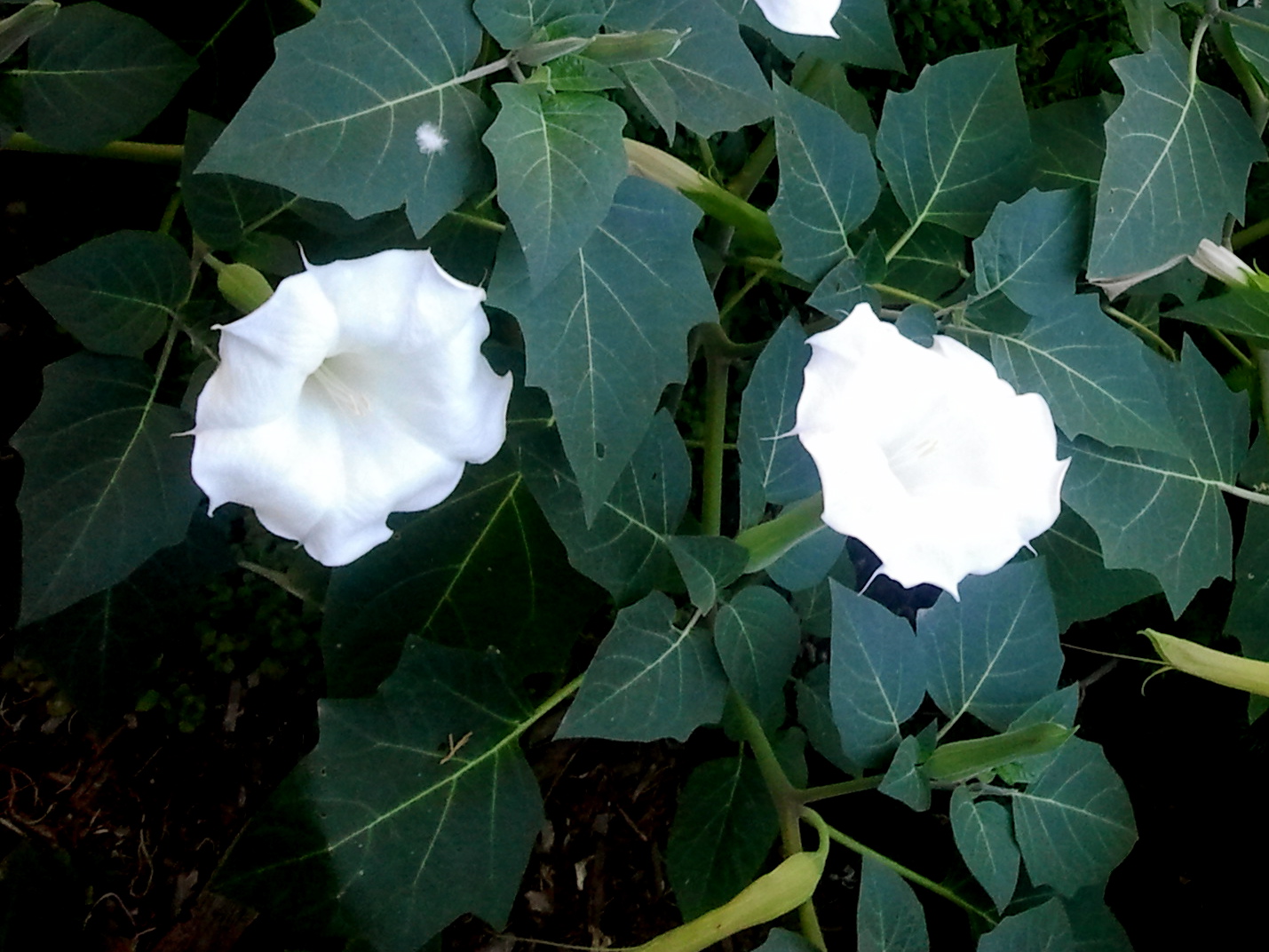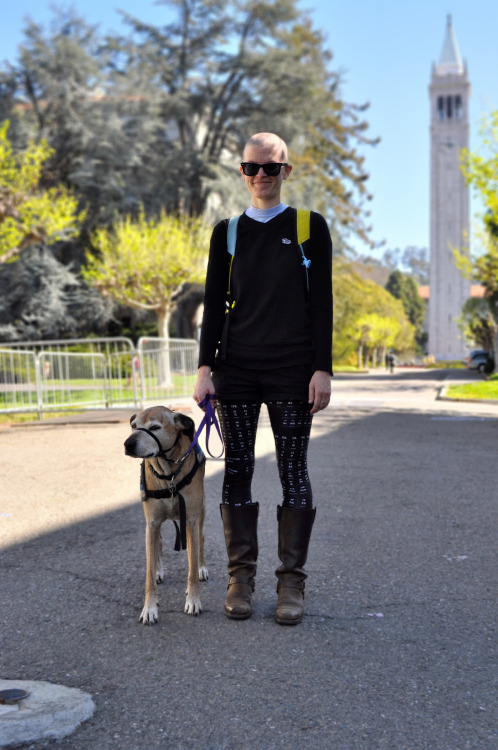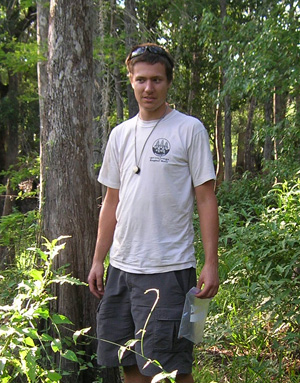Former Lab Members
Christina Kilbane
Undergraduate Research Associate

Duration in the Bohs lab: 2014 to present.
Projects: General Solanaceae lab research, including Cyphomandra and its related clades, which includes the recently described Solanum zumbense [pictured below], and now broadening work on the Lycianthes and Capsicum projects.

Favorite solanaceae taxon: Datura inoxia Mill. is my favorite because it has a rich history with the Aztecs (as being highly toxic but also medicinal) and it has a beautiful inflorescence that blooms at night and smells beyond divine.

Least favorite solanaceae taxon: I don't have a least favorite. Yet...
Charity Z. Goeckeritz
Undergraduate Research Associate

Duration in the Bohs lab: 2014 to present.
Projects: General Solanaceae lab and greenhouse research, including Cyphomandra and its related clades, and documenting taxa for the Solanaceae Source website.
Favorite solanaceae taxon: Solanum glaucophyllum! If the fact that it is in the Cyphomandra group doesn’t already make me biased, it is amazing all on its own. It has lovely, lavender stellate corollas and a fragrance to die for. Not only is it beautiful, but it also has some medicinal uses. One of the most striking includes the use for calcium absorption; S. glaucophyllum contains a compound that functions like vitamin D, and increases calcification of soft tissues.
Least favorite solanaceae taxon: If I had to choose, my least favorite Solanaceae would have to be Solanum ensifolium merely because I have a personal vendetta with the specimen inhabiting our greenhouse. It is covered in spines that even appear on the main veins of leaves. As a result, it (painfully) snags on EVERYTHING. However, S. ensifolium is actually an endangered species due to habitat loss, so I have a special kind of respect for it. After all, if my habitat was being destroyed, I’d have a pretty thorny personality as well.
Genevieve Walden
Postdoctoral Research Associate

Projects: Systematics of Lycianthes and Capsicum, other work on Cyphomandra and clades with Christina Kilbane and Charity Goeckeritz, and curatorial activities with the Garrett Herbarium. See Walden website for other research.

Lycianthes biflora

Capsicum ciliatum accession

Solanum betaceum
Eric J. Tepe
Postdoc

Eric was a Postdoctoral Research Associate in the Bohs lab and is now an Assistant Professor at the University of Cincinnati, in Cincinnati, Ohio.

Representatives of the "potato clade" of Solanum. (a) S. brevifolium - sect. Anarrhichomenum; (b) S. caripense - sect.Basarthrum; (c) S. lycopersicon - sect. Lycopersicum; (d) S. anceps - sect. Pteroidea; and (e) S. stenophyllidium - sect. Petota.
Read more about Eric
Frank Farruggia
Postdoc

Frank was a Postdoctoral Research Associate in the Bohs lab and now works for the Environmental Protection Agency in Washington D.C.
Read more about Frank
Gregory A. Wahlert
Postdoc

Greg was a Postdoctoral Research Associate in the Bohs lab, and now works for Myriad Genetics just up the road curing cancer.
Read more about Greg
Félix Guzmán Díaz
PhD student

The projects that Félix focused on most during his time in the Bohs Lab were the relationship among species of Capsicum and Lycianthes.
What are the relationships among economically important plants and their wild relatives? In many cases, we do not know the immediate ancestors of domesticated species. The Solanaceae is an ideal family for this type of study because there are a number of economically important plants in different parts of the family, and this allows for comparison among groups. Important species in this family include food plants such as tomato (Solanum lycopersicum), potato (S. tuberosum), eggplant (S. melongena), and chili peppers (Capsicum spp.); drug plants such as tobacco (Nicotiana tabacum) and mandrake (Mandragora officinarum), and ornamentals such as petunia (Petunia hybrida).
The genus Capsicum is a good model system for this kind of study because it includes relatively few species (about 30), both domesticated (5) and wild (~25), and a clearly identifiable economically important trait (pungency - the organoleptic sensation of heat). Thus the specific questions I will address are:
1) What are the evolutionary relationships among Capsicum species?
2) Are the wild relatives the forms that the cultivated species were domesticated from, or are they cultivated forms that have escaped and are growing wild again?
3) What are the patterns of molecular evolution of pungency?
Some recent publications:
Castiñeiras, L., F.A. Guzmán, M.C Duque T. Shagarodsky, R. Cristóbal and M. C. de Vicente. 2007. AFLPs and morphological diversity of Phaseolus lunatus L. in Cuban home gardens: approaches to recovering the lost ex situ collection. Biodiversity and Conservation 16:2847-2865.
Guzmán, F.A., S. Moore F., M.C. de Vicente and M. Jahn. 2006. Development of a molecular tool to allow worldwide comparison of Capsicum germplasm. In PAA/Solanaceae 2006. Genomics meets biodiversity. Madison, Wisconsin, 23-27 July 2006.
Guzmán, F.A., H. Ayala, C. Azurdia, M.C. Duque and M.C. de Vicente. 2005. AFLP assessment of genetic diversity of Capsicum genetic resources in Guatemala: Home gardens as an option for conservation. Crop Science 45:363–370.
de Vicente, M.C., F.A. Guzmán, J. Engels and V. Ramanatha Rao. 2005. Genetic characterization and its use in decision making for the conservation of crop germplasm. Pp. 121-128 in International workshop the role of biotechnology for the characterization and conservation of crop, forestry, animal and fishery genetic resources. FAO, FOBIOTECH, ECOGENE, SIGA. Turin, Italy, 5-7 March 2005.
Guzmán, F. A. & M.C. de Vicente. 2004. Linking in situ and ex situ conservation through home gardens. In: Italia. Geneflow – 2004, Special section p.19 – 19.
Guzmán, F.A., O. Toro, C. Ocampo, I. Sánchez, H. Cárdenas and D. Debouck. 2001. Observations about risks of genetic erosion and drift during multiplication and regeneration of germplasm, using wild common bean as model. Annual Report of the Bean Improvement Cooperative (BIC), USA, Vol. 44: 29-30.
Guzmán, F.A., I. Sánchez, H. Cárdenas and D. Debouck. 2000. Genetic erosion control in a germplasm bank. P. 264 in Memorias del XVIII Congreso Nacional de Fitogenética: Notas científicas. SOMEFI. Chapingo, Mexico.
Stephen Stern
PhD student

Stephen was a Ph.D. student in the Bohs lab and now is an assistant professor at Colorado Mesa University in Grand Junction, Colorado.
Read more about Stephen
Andrew Crowl
Undergraduate Research Assistant

Andrew assisted with the collection of molecular sequence data for many Solanum species from 2009–2010, and is now a Ph.D. candidate at the Florida Museum of Natural History - studying evolution and biogeography of the Campanulaceae clade, focusing primarily on rare, endemic taxa in the Mediterranean Basin.
Some of Crowl's recent publications:
Crowl, A; et al. (2016) A global perspective on Campanulaceae: Biogeographic, genomic, and floral evolution. American Journal of Botany, 1-13.
Crowl, A; et al. (2015) Evolution and Biogeography of the Endemic Roucela complex (Campanulaceae: Campanula) in the Eastern Mediterranean. Ecology and Evolution, doi: 10.1002/ece3.1791.
Crowl, A; et al. (2014) Phylogeny of Campanuloideae (Campanulaceae) with emphasis on the utility of nuclear pentatricopeptide repeat (PPR) genes. PLoS ONE,doi: 10.1371/journal.pone.0094199.
Kipp Lee
Undergraduate Research Assistant

Kipp maintained the living Solanum collection in the University greenhouse. He also performed pollination experiments among many species to determine breeding systems and collect vouchers. He won "Garden of the Month" for July 2009 from the Intermountain Native Plant Growers Association.
Karena Leo
Undergraduate Research Assistant
>
Karena did almost everything in the Bohs lab, and researched the Dulcamaroid clade. She is now successfully in grad school and living her best life.
Ruedigar Matthes
Undergraduate Research Assistant

Rudi worked in the lab on molecular phylogenetic work on the many, various Solanum species.
Cameron McIntire
Undergraduate Research Assistant

Cameron maintained the living Solanum collection in the University greenhouse. He also performed pollination experiments among many species.
Andrew Van Wagenen
Undergraduate research assistant

Andrew maintained research plants in the greenhouse including collecting data on the breeding systems in Solanum, and molecular phylogenetics research.
Some of Van Wagenen's recent publications:
Bohs, L., T. Weese, N. Myers, V. Lefgren, N. Thomas, A. Van Wagenen, and S. Stern. Zygomorphy and heterandry in Solanum in a phylogenetic context. Acta Horticulturae 745: 201-223. PDF

